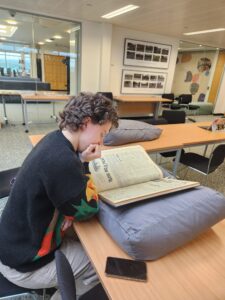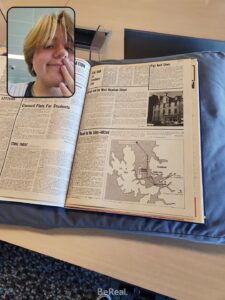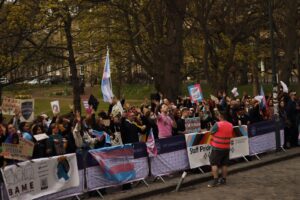“We have always been here. And we always will be”
What does it mean to be queer in Edinburgh?
 Ash is a fourth year History and Politics student, and student ambassador.
Ash is a fourth year History and Politics student, and student ambassador.
Ever since arriving at the university as a queer person, I have felt that there such a wide array of queer events, LGBTQ+ societies and groups in the city, but the amazing queer life and activism on campus is severely lacking the representation that it deserves. It’s quite easy for a lot of people to fall into the narrative of LGBTQ+ identities being a ‘new thing’, or not considering the amount of work and activism that was necessary to gain rights and acceptance for the queer community. Especially universities have played an enormous role in establishing LGBTQ+ networks, and student activism is a huge tool for change, and I really wanted to shine light on this.
Over the past year, a small volunteer group and I have been creating a database of student LGBTQ+ sources in the Centre for Research Collections, reaching from editions of ‘The Student’ newspaper, the Staff-Student Bulletin, or mentions of the university in publications such as ‘Gay Scotland’. Our work has been a mix of remote and in-person, given that some of the sources we use are digitized and accessible, while others are only available physically. Queer life was not always present in the form we recognize it today; we found the establishment of the Gay Society in 1973 but also occasional reports on gay life through the 1970s, 80s and 90s. There are a lot of silences that we are facing, for example the exclusion of trans and BME (Black & Minority Ethnic) members of the community.
And what started as a passion project of mine snowballed into a much bigger project. I was able to secure partial funding for the project through the ‘Staff Student Agreement’ small project fund, and we soon realised that there are many more sources and stories than we originally anticipated. We started identifying themes that emerged from our research, such as student activism, the emergence of LGBTQ+ societies, and what queer student life was like in the past, trying to connect the dots between them.
After a panel event with GENDER.ED, where I presented our research thus far, and panellists shared their insights about the importance of community-led archive work, we got approached by the School of History, Classics, and Archaeology about creating a physical exhibition of our findings, and I was absolutely ecstatic! We received so much support and positive receptions for the research we had been doing, so we knew we had to take the opportunity. Over the summer, I worked together with the Marketing and Communications Team in the School, Julie Gibbings as the EDI Lead, and Ann Harrison, a wonderful designer at the College of Arts, Humanities and Social Sciences. We curated our findings into different sections alongside the themes we had been exploring, trying to piece together a narrative of what queer life at Edinburgh University looked like, and continues to look like.
 The small exhibition is an accumulation of our work over the past year but is by no means exhaustive. It provides some glimpses into the incredible work of queer student activists and community members throughout a time of significant repression and discriminatory laws against queer life. The exhibition wants to take up space for an underrepresented community, with us queer students being able to manifest our belonging at the university through having a visual reminder of our historical presence here.
The small exhibition is an accumulation of our work over the past year but is by no means exhaustive. It provides some glimpses into the incredible work of queer student activists and community members throughout a time of significant repression and discriminatory laws against queer life. The exhibition wants to take up space for an underrepresented community, with us queer students being able to manifest our belonging at the university through having a visual reminder of our historical presence here.
The cloth wall panels have specifically been chosen to represent the fluidity of the queer experience – our identities are not stagnant and cannot be put into boxes. The air of people walking past will shift the panels into different directions, and it is up to the viewer to decide what this shifting and fluidity means for themselves. An ‘ALWAYS’ is spelled at the bottom of the panels, with colours running into each other through a gradient, asserting simultaneously the historical belonging of queer people to the university, regardless of discriminatory practices and laws, while also underlining that this belonging is diverse, and that this diversity should be welcomed.
The first part explores the emergence of a LGBTQ+ Society at the University, with the first available Constitution in 1973, established as “Edinburgh University Gay Group”. Throughout its existence, the group was renamed several times, from “Gay Group,” to “Lesbian and Gay Society” in 1982, further to “BLOGS (Bisexual, Lesbian or Gay Society)” in the early 1990s, to “PrideSoc” only recently, showing the increasing visibility and acceptance of different identities within the society throughout its existence. The society ran a variety of campaigns and events, collaborated with gay societies at other universities, produced a newsletter, and created a “Gay Awareness Week.” However, throughout its existence, the society also faced high opposition in the university community, collapsing in 1981 for a while due to ongoing harassment on campus.
When it comes to student activism, both the society and unaffiliated students were heavily involved in liberation campaigns for the community. In response to Section 28, a Local Government Act section to “prohibit the promotion of homosexuality by local authorities”, the Lesbian and Gay Society mobilised the student community, with a march in June 1998, as well as creating a Lesbian and Gay Bookstall in response to the censorship of queer literature in libraries. The solidarity among the wider university community remained mixed, as there were several supporters of the Section, for example a university Chaplain or different student societies, but a few articles we found were also sympathetic with queer students. More recently, students have organised and mobilised protests around trans rights at the university and brought the topic of LGBTQ+ rights at the forefront of student concerns, seen for example through the initiation of a Gender Empowerment Fund.

Student life was also a big topic of queer students. In the early 1970s, the Gay Soc and the SMG provided the biggest hub of queer social life within the city. They organised gay discos, reading groups, Halloween parties, drag shows, and other gatherings, either in ‘safe’ bars (which were known to be gay friendly) or in private spaces. A few examples of these were “The Kenilworth” on Rose Street, “The Nelson” in the New Town area or “Fire Island Disco” on Princes Street. Gay organisations as the centre for queer student life did not massively change over the next few decades, especially during the ostracization of the gay scene during the AIDS crisis and the prohibition of official advertisements under Section 28. However, towards the late 1980s, we found an emerging discussion in ‘The Student’ about queer life in Edinburgh, from bars and clubs to other social events. Having the opportunity to engage with others, either in ‘safe bars’, in placard making sessions, or awareness lectures, was, and still is, incredibly important.
Queer student life at the university has grown significantly since the first attempts to carve out space for the community on campus. There are several different queer societies active on campus, for example PrideSoc, LGBTQ+ Law, or EdiUniCorn (East Asian and Southeast Asian Queer Society), organising social and informative events, such as coffee meetups, safer sex workshops, film screenings, or club nights. But also, queer student life outside of organised societies has been flourishing, for example with the initiation of the drag show “Fruit Salad” by Edinburgh students. Without the work of student activists in the past, these successes would have not been possible at all, and we found a sense of intergenerational solidarity with the queer students that came before us through our research.
We have always been here, and we always will be.
Find out more
“We have always been here. And we always will be.” – A new exhibition